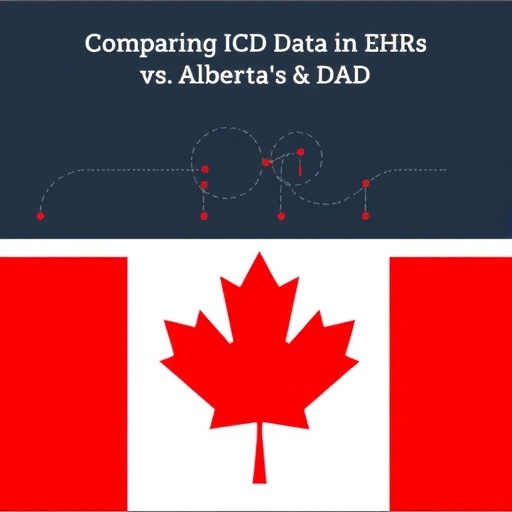In the rapidly evolving landscape of healthcare data management, the ability to harmonize different healthcare data sources has never been more crucial. The advent of electronic health records (EHR) has transformed how patient information is stored, retrieved, and analyzed, yet inconsistencies among data sources remain a significant hurdle. A recent study by Sandhu et al. shines a light on this issue by comparing the International Classification of Diseases (ICD) data mapped in EHR systems to the hospital Discharge Abstract Database (DAD) data in Alberta, Canada. This comparative analysis unfolds in such a manner that it reveals not only the discrepancies but also the implications of these findings for healthcare delivery and research effectiveness.
The core objective of this study is to delve into the reliability and validity of different data sources in the context of healthcare service research. By examining the ICD data within EHR systems and contrasting it with the established DAD data, the authors aim to assess the degree of alignment between these two key datasets. The significance of this research lies in its potential to guide healthcare professionals, policymakers, and researchers in making informed decisions based on accurate and comprehensive data. The effectiveness of any healthcare system hinges on the quality of data it utilizes, hence the relevance of this investigation cannot be overstated.
One compelling aspect of the study is its methodological rigor. The researchers employed a robust analytical framework to evaluate the discrepancies between the mapped ICD codes in the EHR system and those recorded in the DAD. This meticulous approach involved the extraction of a wide range of diagnostic information, allowing the team to perform a thorough assessment of data congruence. Statistical analyses were carried out to quantify the extent of alignment and identify patterns that may indicate systemic issues within the data mapping processes.
As the study unravels the nuances of data comparison, it becomes apparent that multiple factors contribute to discrepancies. Issues such as variations in coding practices, differences in clinical documentation processes, and the inherent complexity of integrating data from diverse health informatics frameworks all play a role. The combination of these elements often results in significant deviations that can impact the overall assessment of patient care and outcomes. This intricate web of factors underscores the need for standardized coding practices and enhanced training for healthcare providers to ensure data accuracy.
Interestingly, the study also emphasizes the importance of technological advancements in bridging data gaps. With the integration of artificial intelligence and machine learning tools in EHR systems, there exists the opportunity for real-time data validation and error correction. The potential for these technologies to enhance the consistency of health records is immense, paving the way for improved patient care and streamlined research capabilities. The insights garnered from this study could serve as a fundamental guide for tech developers and healthcare administrators alike, highlighting the need for systems that can adapt to the dynamic nature of medical knowledge and coding practices.
As healthcare systems increasingly adopt EHRs, understanding the implications of data discrepancies on clinical practice is pivotal. Inaccurate coding can lead to misinterpretations of patient histories, inappropriate treatment decisions, and financial penalties for healthcare institutions. Moreover, this can significantly skew data used for public health research and epidemiological studies, resulting in misguided health policies. The findings presented by Sandhu et al. bring to the forefront the pressing need for continuous monitoring and evaluation of data integrity in healthcare settings.
One cannot overlook the socio-economic ramifications engendered by such disparities in health data. Regions that rely heavily on the accuracy of health records for funding and resource allocation may inadvertently suffer due to inaccuracies in coded data. Furthermore, marginalized communities could face adverse outcomes due to the lack of precise health information, which often informs health programs and interventions aimed at them. The ethical implications of these findings are profound, urging stakeholders to foster an equitable healthcare system where data reliability is paramount.
The study offers compelling evidence that can serve as a catalyst for future research initiatives focused on data quality. By advocating for a paradigm shift in how health information is recorded and accessed, the authors illuminate pathways to better align ICD data across platforms. The systematic evaluation presented in this research can inspire follow-up studies aiming to enhance interoperability between EHR systems and various health databases, contributing to the overarching goal of improved patient care.
The results of the Sandhu et al. study ultimately call for concerted efforts among healthcare providers, decision-makers, and researchers to engage in continuous discourse regarding data standardization and quality assurance. Such collaboration is necessary to facilitate the development of innovative strategies to reconcile data inconsistencies. By leveraging insights from this study, stakeholders can work toward fostering an empowered healthcare ecosystem characterized by precision and trust.
In concluding this pivotal research discussion, the wider implications of these findings extend beyond the realm of Alberta, Canada, resonating globally within the healthcare community. As nations move towards digital health solutions, the lessons learned from this comparative analysis can inform best practices and proactive measures. By prioritizing data integrity in health records, the potential for enhanced patient outcomes and safety becomes a tangible reality.
In the face of these complex challenges, one thing remains clear: the journey towards optimal healthcare data management is ongoing. It necessitates a collaborative, multi-faceted approach that embraces technological innovation, ethical considerations, and a steadfast commitment to improving the quality of care delivered to populations worldwide. The insights derived from the research led by Sandhu et al. are not just academic; they are vital tools for enacting real change in the healthcare landscape.
As healthcare systems continue to navigate the complexities of public health demands and technological advancements, comparative studies that scrutinize data accuracy will be invaluable. The legacy of research such as this serves not only to highlight existing challenges but also to pave the way for a future where informed decision-making in healthcare can flourish, ultimately leading to enhanced service delivery and patient satisfaction.
Subject of Research: Comparison of ICD Data in EHR Systems and Hospital DAD Data
Article Title: How does the mapped ICD data in an EHR system compare to the hospital DAD data in Alberta, Canada?
Article References:
Sandhu, N., Onos, D., Li, B. et al. How does the mapped ICD data in an EHR system compare to the hospital DAD data in Alberta, Canada?. BMC Health Serv Res 25, 1523 (2025). https://doi.org/10.1186/s12913-025-13716-3
Image Credits: AI Generated
DOI: https://doi.org/10.1186/s12913-025-13716-3
Keywords: Healthcare Data Management, Electronic Health Records, ICD Code Comparison, Data Integrity, Health Informatics.
Tags: Alberta Discharge Abstract Databasedata integrity in patient recordsdata source harmonization in healthcarediscrepancies in medical dataelectronic health records analysishealthcare data management challengeshealthcare decision-making based on datahealthcare policy implicationshealthcare research effectivenessICD data comparisonimplications for healthcare deliveryreliability of ICD coding in EHRs





